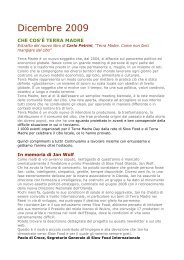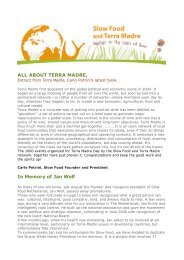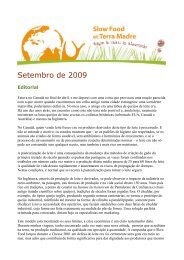all the food that's fit to print The Education Issue - Slow Food
all the food that's fit to print The Education Issue - Slow Food
all the food that's fit to print The Education Issue - Slow Food
Create successful ePaper yourself
Turn your PDF publications into a flip-book with our unique Google optimized e-Paper software.
Teaching <strong>the</strong> Next Generation of Eaters<br />
— By Richard Villadóniga<br />
How <strong>to</strong> get middle schoolers <strong>to</strong> think about <strong>food</strong><br />
remember reading Fast <strong>Food</strong> Nation for <strong>the</strong><br />
I first time and thinking <strong>to</strong> myself that I had<br />
<strong>to</strong> share it with my students. I wanted each of<br />
<strong>the</strong>m <strong>to</strong> know exactly what was going on each<br />
time <strong>the</strong>y ingested ano<strong>the</strong>r so-c<strong>all</strong>ed “Happy”<br />
Meal. Apparently I was not alone; Eric Schlosser<br />
followed up with a children’s version c<strong>all</strong>ed Chew<br />
On This: Everything You Don’t Want <strong>to</strong> Know About<br />
Fast <strong>Food</strong>.<br />
As a middle school social studies teacher I<br />
know firsthand that getting kids <strong>to</strong> think about<br />
<strong>the</strong> <strong>food</strong> <strong>the</strong>y are eating, what’s in it, and where<br />
it comes from is no easy task—especi<strong>all</strong>y at this<br />
age. <strong>The</strong>y are beyond <strong>the</strong> point where having<br />
<strong>the</strong>m simply grow a few sprouts of anything<br />
in a sm<strong>all</strong> pot will re<strong>all</strong>y mean something <strong>to</strong><br />
<strong>the</strong>m, but <strong>the</strong>y are not quite at <strong>the</strong> intellectual<br />
level of high school students when it comes <strong>to</strong><br />
having a provocative discussion. Sometimes it<br />
takes potty humor <strong>to</strong> get middle schoolers <strong>to</strong><br />
pay attention, and you must always be energetic<br />
and entertaining, but with Chew On This, I could<br />
read one gripping passage after ano<strong>the</strong>r <strong>to</strong> my<br />
students—you could hear a pin drop—and I<br />
could follow <strong>the</strong>m up with good discussions on<br />
how it <strong>all</strong> related <strong>to</strong> <strong>the</strong>ir lives and diets. It’s a<br />
magnificent <strong>to</strong>ol <strong>to</strong> capture my students’ interest<br />
and a great segue in<strong>to</strong> my annual <strong>food</strong> unit.<br />
Over a period of two <strong>to</strong> three weeks, my<br />
students read <strong>the</strong> latest articles on sustainable<br />
farming and answer critical thinking questions<br />
about what <strong>the</strong>y read. We talk about <strong>the</strong> types of<br />
things <strong>the</strong>y eat in a typical week. I bring in <strong>food</strong><br />
and <strong>the</strong>y try <strong>to</strong> guess where it was produced—<br />
mangoes from Mexico, walnuts from California,<br />
pasta from Italy, etc. We are pretty fortunate <strong>to</strong><br />
live in nor<strong>the</strong>ast Florida, where a long growing<br />
season and a tradition of agriculture <strong>all</strong>ow us <strong>to</strong><br />
produce many crops throughout <strong>the</strong> year, so I<br />
am sure <strong>to</strong> include local <strong>food</strong>s (such as pota<strong>to</strong>es,<br />
cabbage, and datil peppers) in<strong>to</strong> <strong>the</strong> mix. I drive<br />
home <strong>the</strong> point that <strong>the</strong> average American meal<br />
travels 1,500 miles from farm <strong>to</strong> table and that this<br />
distance has great ecological, economic, and social<br />
consequences. <strong>Slow</strong>ly but surely, <strong>the</strong> concept of<br />
eating loc<strong>all</strong>y and in accordance with <strong>the</strong> seasons<br />
begins <strong>to</strong> sink in. Though I may not make converts<br />
of <strong>the</strong>m <strong>all</strong>, by midway through <strong>the</strong> unit, most of<br />
<strong>the</strong>m are at least questioning <strong>the</strong>ir own diets and<br />
<strong>the</strong> relationship <strong>the</strong>y never knew <strong>the</strong>y had with<br />
<strong>the</strong>ir <strong>food</strong> and <strong>the</strong> people who produce it.<br />
We also talk about <strong>the</strong> problems of <strong>the</strong><br />
mainstream approach <strong>to</strong> <strong>food</strong> production, such as<br />
<strong>the</strong> alarming use of child slaves in African cacao<br />
plantations, and alternatives (fair trade chocolate,<br />
for example). This re<strong>all</strong>y gets <strong>the</strong> kids thinking.<br />
(“<strong>The</strong>y use child slaves <strong>to</strong> make my chocolate bar?<br />
What can we do about this?”)<br />
I try <strong>to</strong> make <strong>the</strong> <strong>food</strong> unit personal. I show<br />
a pho<strong>to</strong>-presentation of <strong>the</strong> 15,000-mile road<br />
trip I <strong>to</strong>ok across <strong>the</strong> US last summer during<br />
which I documented endangered <strong>food</strong>s and <strong>food</strong><br />
traditions and <strong>the</strong> s<strong>to</strong>ries of <strong>the</strong> individuals that<br />
are working <strong>to</strong> preserve <strong>the</strong>m. We analyze our<br />
We analyze our own<br />
school cafeteria menus<br />
and circle <strong>the</strong> items that<br />
were produced loc<strong>all</strong>y,<br />
in season, and that sound<br />
nutritious; <strong>the</strong>re aren’t <strong>to</strong>o<br />
many circles on <strong>the</strong> page<br />
when we are done<br />
own school cafeteria menus and circle <strong>the</strong> items<br />
that were produced in Florida, those that are in<br />
season, and <strong>the</strong> ones that sound nutritious. As<br />
you can imagine, <strong>the</strong>re aren’t <strong>to</strong>o many circles<br />
on <strong>the</strong> page when we are done with <strong>the</strong> exercise.<br />
<strong>The</strong> culminating assignment of <strong>the</strong> unit is for<br />
my students <strong>to</strong> write a five-paragraph persuasive<br />
letter <strong>to</strong> <strong>the</strong> school cafeteria manager urging<br />
her <strong>to</strong> incorporate more local, seasonal, organic<br />
<strong>food</strong> in<strong>to</strong> <strong>the</strong> school menus. This conveniently<br />
happens <strong>to</strong> be a great way for my students <strong>to</strong> hone<br />
<strong>the</strong> critical thinking and writing skills that are<br />
measured in our state’s standardized tests.<br />
Fin<strong>all</strong>y, as a treat at <strong>the</strong> end, we watch <strong>the</strong><br />
education<strong>all</strong>y enhanced version of “Supersize Me”<br />
<strong>to</strong>ge<strong>the</strong>r and I get <strong>to</strong> witness not only Morgan<br />
Spurlock’s incredible transformation, but that of<br />
my students from ignorant eaters <strong>to</strong> informed<br />
ones. And that’s what teaching is <strong>all</strong> about.<br />
Richard Villadóniga is a geography teacher in St. Johns County,<br />
Florida. He is <strong>the</strong> convivium leader of <strong>the</strong> recently founded First<br />
Coast convivium. Read about his Endangered <strong>Food</strong>s Tour at www.<br />
eat-american.com.<br />
<strong>The</strong> snail | spring 2008<br />
9







